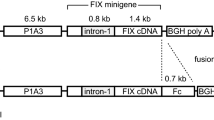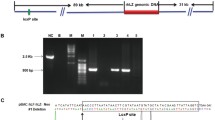Abstract
The human tissue-type plasminogen activator (tPA) is a key kinase of fibrinolysis that plays an important role in dissolving fibrin clots to promote thrombolysis. The recombinant human plasminogen activator (rhPA) has more thrombolytic advantages than the wild type tPA. To increase the half-life and thrombolytic activity of tPA, a mutant containing only the essential K2 fibrin-binding and P activating plasminogen domains of the wild type tPA was cloned. This fragment was then inserted into goat β-casein regulatory sequences. Then, a mammary gland-specific expression vector, PCL25/rhPA, was constructed, and the transgenic rabbits were generated. In this study, 18 live transgenic founders (12♀, 6♂) were generated using pronuclear microinjection. Six transgenic rabbits were obtained, and the expression levels of rhPA in the milk had a range of 15.2–630 µg/ml. A fibrin agarose plate assay of rhPA showed that it had strong thrombolytic bioactivity in vitro, and the highest specific activity was >360 (360 times more than that of alteplase). The results indicated that the rhPA containing only the K2 and P domains is efficiently expressed with higher thrombolytic bioactivity in the milk of transgenic rabbits. Our study also demonstrated a new method for the large-scale production of clinically relevant recombinant pharmaceutical proteins in the mammary glands of transgenic rabbits.





Similar content being viewed by others
References
Barrett AJ (2004) Handbook of proteolytic enzymes. E-STREAMS: electronic reviews of science and technology. Elsevier, Amsterdam, pp 2946–2952
Baumer W, Herrling GM, Feige K (2013) Pharmacokinetics and thrombolytic effects of the recombinant tissue-type plasminogen activator in horses. BMC Vet Res 9:158
DeMers G, Meurer WJ, Shih R, Rosenbaum S, Vilke GM (2012) Tissue plasminogen activator and stroke: review of the literature for the clinician. J Emerg Med 43(6):1149–1154
Collen D, Lijnen HR (2009) The tissue-type plasminogen activator story. Arterioscler Thromb Vasc Biol 29(8):1151–1155
Khodabakhsh F, Dehghani Z, Zia MF, Rabbani M, Sadeghi HM (2013) Cloning and expression of functional reteplase in Escherichia coli Top10. Avicenna J Med Biotechnol 5(3):168–175
Lin L, Hu K (2014) Tissue plasminogen activator and inflammation: from phenotype to signaling mechanisms. Am J Clin Exp Immunol 3(1):30–36
Hong-Ying SS-GL, Jian-Quan C (2006) Expression of a variant of human tissue-type plasminogen activator in transgenic mouse milk. J Exp Anim Sci 43(3):211–218
Lijnen HR, Collen D (1991) Strategies for the improvement of thrombolytic agents. Thromb Haemost 66(1):88–110
Shafiee F, Moazen F, Rabbani M, Mir Mohammad Sadeghi H (2015) Optimization of the expression of reteplase in Escherichia coli Top10 using arabinose promoter. Jundishapur J Nat Pharm Prod 10(1):e16676
Smalling RW, Bode C, Kalbfleisch J, Sen S, Limbourg P, Forycki F, Habib G, Feldman R, Hohnloser S, Seals A (1995) More rapid, complete, and stable coronary thrombolysis with bolus administration of reteplase compared with alteplase infusion in acute myocardial infarction. Circulation 91(11):2725–2732
Lian LF, Xu F, Tang ZP et al (2014) Intraclot recombinant tissue-type plasminogen activator reduces perihematomal edema and mortality in patients with spontaneous intracerebral hemorrhage. J Huazhong Univ Sci Technol 34:165–171
Dotan A, Kaiserman I, Kremer I, Ehrlich R, Bahar I (2014) Intracameral recombinant tissue plasminogen activator (r-tPA) for refractory toxic anterior segment syndrome. Br J Ophthalmol 98(2):252–255
Meunier JM, Wenker E, Lindsell CJ, Shaw GJ (2013) Individual lytic efficacy of recombinant tissue plasminogen activator in an in vitro human clot model: rate of “nonresponse”. Acad Emerg Med 20(5):449–455
Verheijen JH, Mullaart E, Chang GT, Kluft C, Wijngaards G (1982) A simple, sensitive spectrophotometric assay for extrinsic (tissue-type) plasminogen activator applicable to measurements in plasma. Thromb Haemost 48(3):266–269
Verheijen JH, Caspers MP, Chang GT, de Munk GA, Pouwels PH, Enger-Valk BE (1986) Involvement of finger domain and kringle 2 domain of tissue-type plasminogen activator in fibrin binding and stimulation of activity by fibrin. EMBO J 5(13):3525–3530
Gillis JC, Wagstaff AJ, Goa KL (1995) Alteplase. A reappraisal of its pharmacological properties and therapeutic use in acute myocardial infarction. Drugs 50(1):102–136
Rijken DC, Groeneveld E, Barrett-Bergshoeff MM (1994) In vitro stability of a tissue-type plasminogen activator mutant, BM 06.022, in human plasma. Thromb Haemost 72(6):906–911
Aghaabdollahian S, Rabbani M, Ghaedi K, Sadeghi HM (2014) Molecular cloning of reteplase and its expression in E. coli using tac promoter. Adv Biomed Res 3:190
Ellis K, Brener S (2004) New fibrinolytic agents for MI: as effective as current agents, but easier to administer. Cleve Clin J Med 71(1):29–30
Rudolph NS (1999) Biopharmaceutical production in transgenic livestock. Trends Biotechnol 17(9):367–374
Lubon H (1998) Transgenic animal bioreactors in biotechnology and production of blood proteins. Biotechnol Ann Rev 4:1–54
Houdebine LM (2009) Production of pharmaceutical proteins by transgenic animals. Comp Immunol Microbiol Infect Dis 32(2):107–121
Bosze Z, Baranyi M, Whitelaw CB (2008) Producing recombinant human milk proteins in the milk of livestock species. Adv Exp Med Biol 606:357–393
Serova IA, Dvoryanchikov GA, Andreeva LE, Burkov IA, Dias LP, Battulin NR, Smirnov AV, Serov OL (2012) A 3387 bp 5′-flanking sequence of the goat alpha-S1-casein gene provides correct tissue-specific expression of human granulocyte colony-stimulating factor (hG-CSF) in the mammary gland of transgenic mice. Transgenic Res 21(3):485–498
Wang Y, Tong J, Li S, Zhang R, Chen L, Wang Y, Zheng M, Wang M, Liu G, Dai Y, Zhao Y, Li N (2011) Over-expression of human lipoprotein lipase in mouse mammary glands leads to reduction of milk triglyceride and delayed growth of suckling pups. PLoS One 6(6):e20895
Brem GBB, Goodman HM et al (1985) Production of transgenic mice, rabbits and pigs by microinjection. Theriogenology 20:251–252
Hammer RE, Pursel VG, Rexroad CE Jr, Wall RJ, Bolt DJ, Ebert KM, Palmiter RD, Brinster RL (1985) Production of transgenic rabbits, sheep and pigs by microinjection. Nature 315(6021):680–683
Xue F, Ma Y, Chen YE, Zhang J, Lin TA, Chen CH, Lin WW, Roach M, Ju JC, Yang L, Du F, Xu J (2012) Recombinant rabbit leukemia inhibitory factor and rabbit embryonic fibroblasts support the derivation and maintenance of rabbit embryonic stem cells. Cell Reprog 14(4):364–376
Fan J, Watanabe T (2003) Transgenic rabbits as therapeutic protein bioreactors and human disease models. Pharmacol Ther 99(3):261–282
Cheng YAL, Yuan YG et al (2012) Hybrid expression cassettes consisting of a milk protein promoter and a cytomegalovirus enhancer significantly increase mammary-specific expression of human lactoferrin in transgenic mice. Mol Reprod Dev 79:573–585
Bayne K (1998) Developing guidelines on the care and use of animals. Ann N Y Acad Sci 862:105–110
Du FXJ, Zhang J et al (2009) Beneficial effect of young oocytes for rabbit somatic cell nuclear transfer. Cloning Stem Cells 11:131–140
Lin TACC, Sung LY et al (2011) Open-pulled straw vitrification differentiates cryotolerance of in vitro cultured rabbit embryos at the eight-cell stage. Theriogenology 75:760–768
Jindal HK, Merchant E, Balschi JA, Zhangand Y, Koren G (2012) Proteomic analyses of transgenic LQT1 and LQT2 rabbit hearts elucidate an increase in expression and activity of energy producing enzymes. J Proteomics 75(17):5254–5265
Granelli-Piperno A, Reich E (1978) A study of proteases and protease-inhibitor complexes in biological fluids. J Exp Med 148(1):223–234
Pennica D, Holmes WE, Kohr WJ, Harkins RN, Vehar GA, Ward CA, Bennett WF, Yelverton E, Seeburg PH, Heyneker HL, Goeddel DV, Collen D (1983) Cloning and expression of human tissue-type plasminogen activator cDNA in E. coli. Nature 301(5897):214–221
Medved L, Nieuwenhuizen W (2003) Molecular mechanisms of initiation of fibrinolysis by fibrin. Thromb Haemost 89(3):409–419
Ebert KM, Selgrath JP, DiTullio P, Denman J, Smith TE, Memon MA, Schindler JE, Monastersky GM, Vitale JA, Gordon K (1991) Transgenic production of a variant of human tissue-type plasminogen activator in goat milk: generation of transgenic goats and analysis of expression. Nat Biotechnol 9(9):835–838
Zhou Y, Lin Y, Wu X, Xiong F, Lv Y, Zheng T, Huang P, Chen H (2012) The high-level expression of human tissue plasminogen activator in the milk of transgenic mice with hybrid gene locus strategy. Mol Biotechnol 50(2):137–144
Nielsen VGMR, Ley ML et al (2014) Tissue-type plasminogen activator-induced fibrinolysis is enhanced in patients with breast, lung, pancreas and colon cancer. Blood coagul fibrinolysis 25:248–253
Kalyan NK, Lee SG, Wilhelm J, Fu KP, Hum WT, Rappaport R, Hartzell RW, Urbano C, Hung PP (1988) Structure-function analysis with tissue-type plasminogen activator. Effect of deletion of NH2-terminal domains on its biochemical and biological properties. J Biol Chem 263(8):3971–3978
Rouf SA, Moo-Young M, Chisti Y (1996) Tissue-type plasminogen activator: characteristics, applications and production technology. Biotechnol Adv 14(3):239–266
Zhang L, Chopp M, Teng H, Ding G, Jiang Q, Yang XP, Rhaleb NE, Zhang ZG (2014) Combination treatment with N-acetyl-seryl-aspartyl-lysyl-proline and tissue plasminogen activator provides potent neuroprotection in rats after stroke. Stroke 45(4):1108–1114
Gaberel T, Macrez R, Gauberti M, Montagne A, Hebert M, Petersen KU, Touze E, Agin V, Emery E, Ali C, Vivien D (2013) Immunotherapy blocking the tissue plasminogen activator-dependent activation of N-methyl-d-aspartate glutamate receptors improves hemorrhagic stroke outcome. Neuropharmacology 67:267–271
Mattes R (2001) The production of improved tissue-type plasminogen activator in Escherichia coli. Semin Thromb Hemost 27(4):325–336
Obukowicz MG, Gustafson ME, Junger KD, Leimgruber RM, Wittwer AJ, Wun TC, Warren TG, Bishop BF, Mathis KJ, McPherson DT et al (1990) Secretion of active kringle-2-serine protease in Escherichia coli. Biochemistry 29(41):9737–9745
Zhang Y, Jiang P, Gao J, Liao J, Sun S, Shen Z, Qin S (2008) Recombinant expression of rt-PA gene (encoding Reteplase) in gametophytes of the seaweed Laminaria japonica (Laminariales, Phaeophyta). Sci China C 51(12):1116–1120
Davami F, Sardari S, Majidzadeh AK, Hemayatkar M, Barkhrdari F, Omidi M, Azami M, Adeli A, Davoudi N, Mahboudi F (2010) Expression of a novel chimeric truncated t-PA in CHO cells based on in silico experiments. J Biomed Biotechnol 2010:108159
Gouveia RM, Morais VA, Peixoto C, Sousa M, Regalla M, Alves PM, Costa J (2007) Production and purification of functional truncated soluble forms of human recombinant L1 cell adhesion glycoprotein from Spodoptera frugiperda Sf9 cells. Protein Expr Purif 52(1):182–193
Masroori N, Halabian R, Mohammadipour M, Roushandeh AM, Rouhbakhsh M, Najafabadi AJ, Fathabad ME, Salimi M, Shokrgozar MA, Roudkenar MH (2010) High-level expression of functional recombinant human coagulation factor VII in insect cells. Biotechnol Lett 32(6):803–809
Jahanian-Najafabadi A, Bouzari S, Oloomi M, Roudkenar MH, Mayr LM (2012) Attempts to express the A1-GMCSF immunotoxin in the baculovirus expression vector system. Biosci Biotechnol Biochem 76(4):749–754
Ebert KM, DiTullio P, Barry CA, Schindler JE, Ayres SL, Smith TE, Pellerin LJ, Meade HM, Denman J, Roberts B (1994) Induction of human tissue plasminogen activator in the mammary gland of transgenic goats. Biotechnology 12(7):699–702
Yang QEHY, Zhou GB, Yang ZQ, Zhu SE (2007) Stepwise in-straw dilution and direct transfer using open pulled straws (OPS) in the mouse: a potential model for field manipulation of vitrified embryos. J Reprod Dev 53:211–218
Acknowledgments
This study was supported by the National Major Special Projects on New Cultivation for Transgenic Organisms (2011ZX08008-004), the Priority Academic Program Development of Jiangsu Higher Education Institutions (PAPD), Jiangsu Co-innovation Center for Prevention and Control of Important Animal Infectious Diseases and Zoonoses, Jiangsu Province Science and Technology Support Project (BE2013679) and the Graduate Research and Innovation Projects in Yangzhou University (CXLX-1435). We thank our teacher, Professor Yong-Cheng, for providing technical assistance. We would also like to thank the laboratory personnel for their roles in helping with this study.
Author information
Authors and Affiliations
Corresponding author
Ethics declarations
Conflict of Interest
The authors declare no conflict of interest.
Rights and permissions
About this article
Cite this article
Song, S., Ge, X., Cheng, Y. et al. High-level expression of a novel recombinant human plasminogen activator (rhPA) in the milk of transgenic rabbits and its thrombolytic bioactivity in vitro. Mol Biol Rep 43, 775–783 (2016). https://doi.org/10.1007/s11033-016-4020-0
Received:
Accepted:
Published:
Issue Date:
DOI: https://doi.org/10.1007/s11033-016-4020-0




